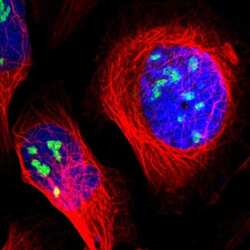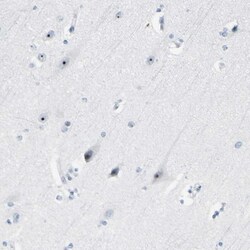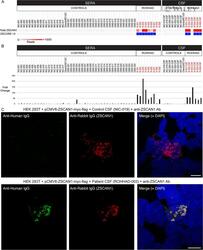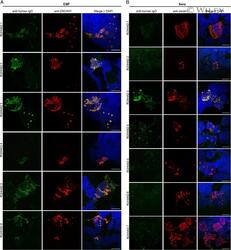Antibody data
- Antibody Data
- Antigen structure
- References [1]
- Comments [0]
- Validations
- Immunocytochemistry [1]
- Immunohistochemistry [1]
- Other assay [2]
Submit
Validation data
Reference
Comment
Report error
- Product number
- PA5-52488 - Provider product page

- Provider
- Invitrogen Antibodies
- Product name
- ZSCAN1 Polyclonal Antibody
- Antibody type
- Polyclonal
- Antigen
- Recombinant protein fragment
- Description
- Immunogen sequence: QPSLKHTKGG TQEAVAGISV VPRGPRGGRP FQCADCGMVF TWVTHFIEHQ KTHREEGPFP CPECGKVFLH NSVLTEHGKI HLLEPPRKKA PRSKGPRESV PPRDGAQGPV APRSPKRPFQ CSVCGKAFPW MVHLIDHQKL Highest antigen sequence identity to the following orthologs: Mouse - 33%, Rat - 34%.
- Reactivity
- Human
- Host
- Rabbit
- Isotype
- IgG
- Vial size
- 100 μL
- Concentration
- 0.20 mg/mL
- Storage
- Store at 4°C short term. For long term storage, store at -20°C, avoiding freeze/thaw cycles.
Submitted references ZSCAN1 Autoantibodies Are Associated with Pediatric Paraneoplastic ROHHAD.
Mandel-Brehm C, Benson LA, Tran B, Kung AF, Mann SA, Vazquez SE, Retallack H, Sample HA, Zorn KC, Khan LM, Kerr LM, McAlpine PL, Zhang L, McCarthy F, Elias JE, Katwa U, Astley CM, Tomko S, Dalmau J, Seeley WW, Pleasure SJ, Wilson MR, Gorman MP, DeRisi JL
Annals of neurology 2022 Aug;92(2):279-291
Annals of neurology 2022 Aug;92(2):279-291
No comments: Submit comment
Supportive validation
- Submitted by
- Invitrogen Antibodies (provider)
- Main image

- Experimental details
- Immunofluorecent analysis of ZSCAN1 in human cell line U-2 OS using ZSCAN1 Polyclonal Antibody (Product # PA5-52488). Staining shows localization to nucleoli.
Supportive validation
- Submitted by
- Invitrogen Antibodies (provider)
- Main image

- Experimental details
- Immunohistochemical analysis of ZSCAN1 in human cerebral cortex using ZSCAN1 Polyclonal Antibody (Product # PA5-52488) shows strong nuclear positivity in neuronal cells.
Supportive validation
- Submitted by
- Invitrogen Antibodies (provider)
- Main image

- Experimental details
- 2 FIGURE Validation of autoantibodies to ZSCAN1 in ROHHAD patients. In panel a and b, enrichment of ZSCAN1 by PhIP-Seq and RLBA was compared between ROHHAD patients (n = 9), non-inflammatory healthy controls (n = 24), and pediatric controls including children with OMS with and without NT (n = 25) and an obesity patient with NT (n = 1). Data represent the average of 2 independent technical replicates. a, PhIP-Seq analysis. Each column represents an individual sample. A heatmap of total ZSCAN1 RP100K is shown in the top row. To enable comparisons between the majority of samples with lower signal we added a ceiling value of 1,000 RP100K. Z-Score enrichments based on our 100 human donor dataset are plotted below, with samples that have Z-score enrichments >3 colored with blue squares. Gray squares indicate Z-score
- Submitted by
- Invitrogen Antibodies (provider)
- Main image

- Experimental details
- 4 FIGURE Validation of ZSCAN1 autoantibodies in CSF and sera of ROHHAD patients using 293 T CBAs. (A) CSF: Immunocytochemistry with 293T cells expressing full-length ZSCAN1 and immunostaining with CSF (1:10) from ROHHAD patients and commercial antibody to ZSCAN1 (rabbit, 1:1000 Invitrogen). Anti-human IgG-488 was used to visualize human IgG, and anti-rabbit IgG-567 was used to visualize anti-ZSCAN1 commercial antibody. Exposure times and post-image processing and thresholding was kept constant across conditions within the experiment. Co-localization was assessed qualitatively through observance of yellow in merged images. (B) Sera: Immunocytochemistry with 293T cells expressing full-length ZSCAN1 and immunostaining with sera (1:100) from ROHHAD patients and commercial antibody to ZSCAN1 (rabbit, 1:1000 Invitrogen). Anti-human IgG-488 was used to visualize human IgG, and anti-rabbit IgG-567 was used to visualize anti-ZSCAN1 commercial antibody. Exposure times and post-image processing and thresholding was kept constant across conditions within the experiment. Co-localization was assessed qualitatively through observance of yellow in merged images. Note colocalization in ROHHAD Sera-1 and -3.
 Explore
Explore Validate
Validate Learn
Learn Immunocytochemistry
Immunocytochemistry